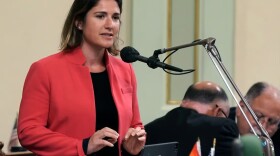A group campaigning to replace San Diego Gas and Electric with a municipal utility has officially gathered more than 24,006 signatures. According to the municipal code, that’s enough to prompt the San Diego City Council to vote on whether to put it on the November ballot.
On Friday, City Clerk Diana Fuentes told the campaign that 24,167 signatures were verified. In an email, Fuentes said a date for the vote hasn’t been set.
The Power San Diego campaign said replacing SDG&E with a non-profit, municipal electric utility would lower rates for customers and encourage the use of rooftop solar power. Bill Powers, the campaign’s chair, points to SDG&E’s record-breaking profits as customers’ rates go up.
“The overarching issue is that we have no control over SDG&E’s activities,” Powers said.
Power San Diego’s original goal of 80,000 signatures would have put the question on the ballot without a council vote, but Powers said they lacked enough funding for that extensive of a campaign.
In April, the council’s Rules Committee declined to move the ballot initiative forward.
“I have no love for corporate monopolies reaching into the pockets of everyday working people, but this is a very complex and important issue, and I don’t think this is baked enough to go to the voters,” Council President Sean Elo-Rivera said at the time.
The ballot initiative says Power San Diego would maintain workers’ hours, wages and other conditions for at least 10 years.
Several union workers with the International Brotherhood of Electrical Workers Local 465 spoke against it during public comment at the committee meeting. Nate Fairman, the union’s business manager, said it would put the working conditions they’ve negotiated at risk.
“Municipalization and this proposal are not union friendly, and the working class families that I represent do not support this,” he said.
The city is paying for a third study on municipalization. Previous studies estimate the value of the utility’s infrastructure at between $1.6 and $4.3 billion.
Power San Diego said the purchase of the electric grid infrastructure would be paid off by customers through low-interest, long-term revenue bonds. They estimate if the utility were city-owned, customers would still see a 20% reduction in their electric bills.
Powers said cities like Los Angeles show municipal utilities can work.
“It works in over 40 other municipalities in the state,” he said. “They have stable rates, and they have higher levels of customer satisfaction.”
An SDG&E-funded analysis found its infrastructure is worth between $7.4 and $9.3 billion. They’re also funding a political action committee to oppose the ballot initiative.






